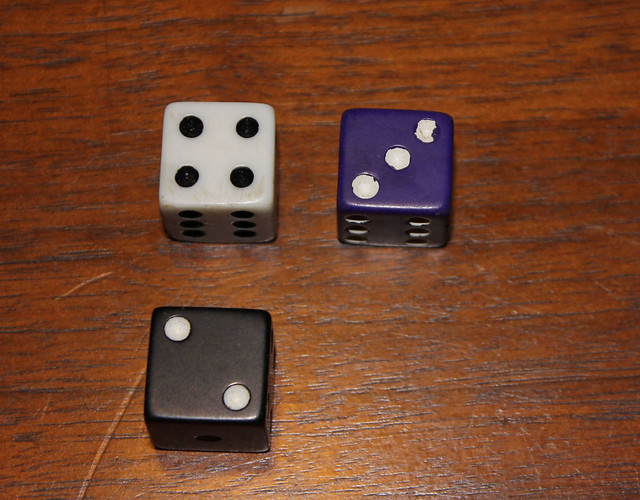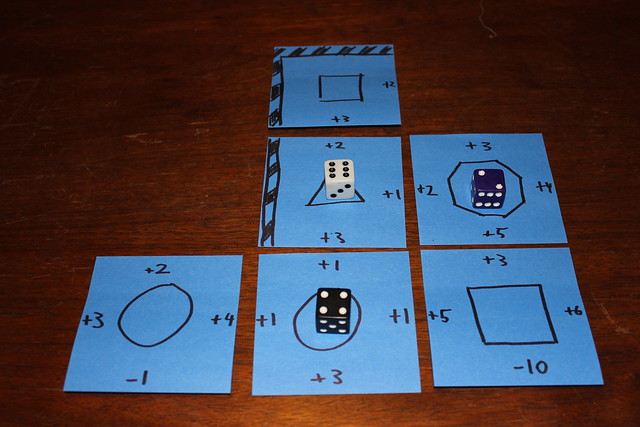Last week I played Guilds of Cadwallon for the first time. It's a very elegant tactical game with some clever nooks and crannies. You can check it out in the video above. It actually reminded me of Triple Triad, an old digital game from the Final Fantasy series that I've occasionally tried to hack into an analog format.
Anyway, here's a simple dice-based game you can play. Each player starts with an equal number of d6s, in their own color. To start the game, players roll all of their dice at once and leave the results as they stand.
On your turn, take one die from the supply (of either color) and place it on the table adjacent (up, down, left, right, not diagonal) to another die thus forming a grid of dice.
The round ends when all dice have been placed.
Then points are earned by surrounding an opponent's die with your die results totaling a number greater than your opponent's die result. Only orthogonal (up, down, left, right) adjacencies are considered, not diagonal. The points earned are equal to the surrounded dice result.

In the simplified example above, the player with dark dice has surrounded the light die with a total of 5, allowing her to score points from the light die. The light die's result is 4, so the dark player earns 4 points.
That's a fine, playable game on its own, but I also got to thinking about how to make it a little more flexible (and possibly marketable). Since going professional this year, I'm increasingly focused on making sure I can bring in some kind of income from what has been a rather idle hobby for the past decade. So, how can I make something sellable out of this idea?
Consider a set with square tiles, a positive or negative number on each side, possibly a wall on one or two sides, and a suit icon in the center. To set up the game, each player draws a tile from the bag and must place a tile adjacent to another tile, Carcassonne style. However the placement is far less restricted than in Carcassonne. You must simply not place a tile adjacent to a walled edge, unless your tile also has a walled edge.
Then you can play the dice game described earlier, but placing the dice on the tiles instead. In considering scoring, you would add your surrounding dice results with the facing numbers on your tiles as well.
Bonus points may be earned for collecting points from spaces with certain suits, or a certain combination of suits over time.

In the example above, the dark player surrounds a light 6 with 6. Normally this would not be sufficient to score the light dice result. However, the dark player has a +1 bonus from the tile below and a +2 bonus from the tile to the right. Thus, she has a greater sum than the light die result and can score 6 points from it. The "captured" tile also rests on a triangle, which may give the dark player some bonus points at the end of the game.
Much like Triple Triad, there are certainly ways to play this without dice. I can see a deck of cards laid out something like the example shown above. (More or less just Triple Triad cards, really.) You draw five at the start of the round, play one on your turn somewhere on the table, and use the base numbers to determine captures.
Instead of using tokens or chips to determine ownership, cards could have an arrow pointing to one edge. When you play a card, that arrow must point towards you. If a card is "captured," the card is rotated so its arrow points to the new owner, thus changing the orientation of its numbers. Perhaps even leading to a chain reaction!
Yeeeesssss. This may be worth exploring as a card game instead. But what theme? What theme, indeed.
No comments:
Post a Comment